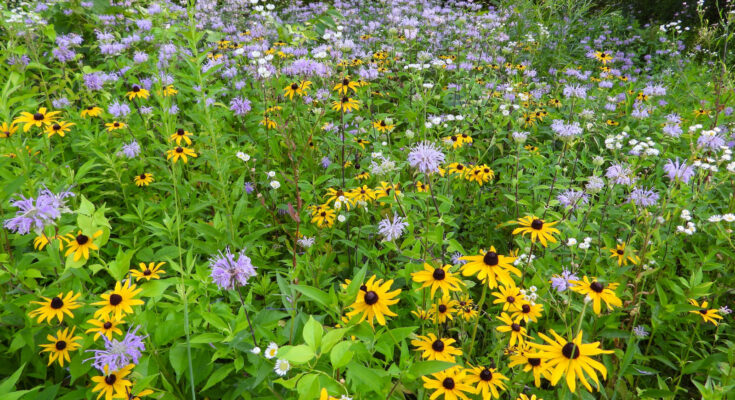Why It May Be Beneficial To Look Into The Prairie Garden Trend For Your Yard
With rising global temperatures and droughts becoming more frequent and severe, maintaining a healthy lawn has become increasingly costly to the homeowner and the planet. Most lawns consist of a single species of grass, and homeowners work hard to keep it that way by watering the lawn every day and applying chemical fertilizers, herbicides, and pesticides. Landscaping services cost Americans nearly $37 billion a year and turfgrass is the largest irrigated crop in the United States. Unfortunately, half of the water never makes it to its intended target. Meanwhile, birds and pollinators face dire futures in part because of lost habitats and poor biodiversity, to which lawns do not contribute. If all this sounds wasteful, the prairie garden look is a landscaping trend you may want to explore.
A prairie garden is an informal garden with a wide variety of native grasses and tall perennial flowers, like the ones you might see growing wild on the plains of the Midwest. Prairie gardens are increasingly popular because they’re low maintenance, cost less than a conventional lawn, and are better for the environment. Compared to a lawn, a prairie garden offers a greater variety of colors, textures, smells, shapes, and activities that change throughout the seasons. Plants that are native to a prairie-type climate are well-adapted to periods of low rainfall and produce nectar that native species of birds and pollinators prefer. Planting your garden with native species will make your garden a more attractive environment for both you and the birds, bees, and butterflies that rely on rich and diverse habitats.
Tips for establishing a prairie garden
To establish a prairie garden, consider the sun exposure, soil type, and moisture level that typical prairie garden plants require. Most need full sun and rich, well-draining soil. However, a prairie garden can be established virtually anywhere if you grow plants native to your region.
Native plants have had millions of years to adapt to their environment, and they need far less care than lawn grasses. These species can survive on the rainwater that naturally makes its way to their roots. Left alone, their nectar and seeds provide readily accessible food for birds, and the seeds that the birds don’t eat fall to the ground and grow into new plants. A well-established prairie garden maintains itself, giving you more time to enjoy it. It’s no wonder that the prairie garden trend is catching on.
Easy-to-grow native flowers include Black-eye Susan, coneflowers, blanket flower, switch grass, wild rye, goldenrod, and columbine. Many of these self-sow and fill out your garden by themselves. Drought-tolerant natives include the many varieties of hyssop, tickseed, sedum, and perennial sunflowers. Crucially, choose species that bloom at different times of year so that there is always something to catch your eye and draw in pollinators. Also, have a look at the many types of prairie grasses you can grow in your prairie garden.



